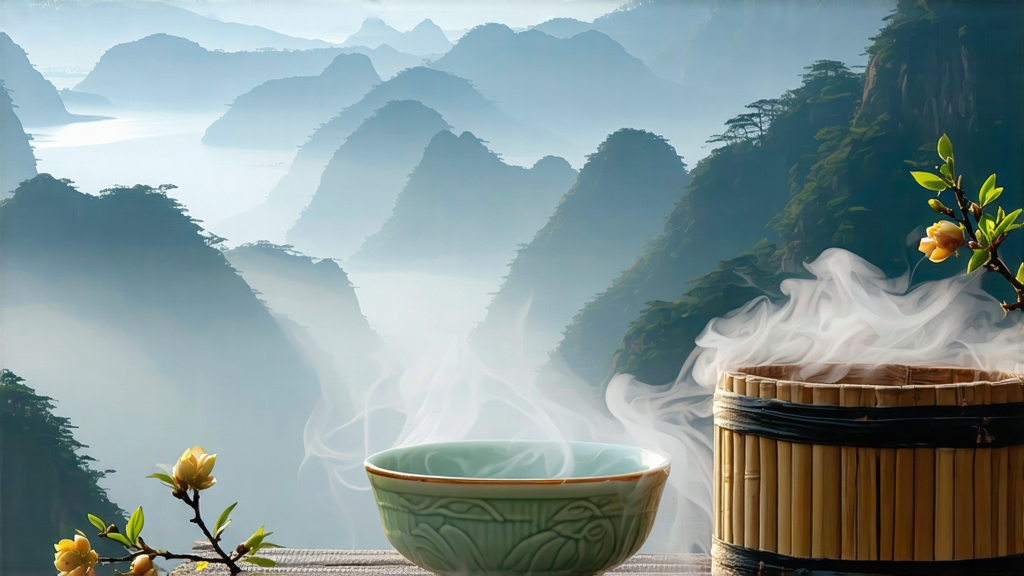
Tucked high on the mist-laden shoulders of Sichuan’s Mengding Mountain, where clouds brush the evergreen crowns and the Min River glints like a silver ribbon below, a tea once reserved for emperors still unfurls its secrets. Meng Ding Huang Ya—literally “Mengding Yellow Bud”—is the quietest celebrity of China’s six major tea families. While green Dragon-Well and fermented Pu-er bask in global limelight, this yellow-gold curiosity slumbers in small bamboo baskets, waiting for the patient drinker who will coax out its apricot-sweet liquor and whispered history of Tang-dynasty courts.
Historical whispers
The first written record appears in 808 CE, when the Tang governor of Ya Prefecture sent “tiny golden shoots” to Chang’an as spring tribute. Legends claim that the Taoist monk Wu Lizhen planted seven tea bushes on Mengding’s summit in 53 BCE; those mother bushes, now protected heritage plants, are still venerated with incense each Qingming. Song-era poet Lu You praised the tea’s “spring color wrapped in light amber,” and the Ming imperial household so coveted it that annual production was capped at 3.6 kilograms, carried to Beijing by fast horses in relay stages reminiscent of the Pony Express. When Qing scholars shifted fashion toward green teas, yellowing techniques nearly vanished; only a handful of mountain families kept the art alive in secret, passing leaf-turning skills from mother to daughter under the light of oil lamps.
Micro-terroir
Mengding’s unique terroir sits at 29° N latitude, 1,400 m above sea level. Frequent cloud cover filters sunlight into soft, diffused rays that slow photosynthesis, concentrating amino acids—especially L-theanine—responsible for the tea’s signature brothy sweetness. Nights dip to 12 °C even in May, locking in floral volatiles. The soil is a crumbly yellow-brown laterite rich in kaolin, offering excellent drainage yet steady moisture; bamboo roots weave through the substrate, lending a faint grassy note that later emerges in the cup. Only the first forty-eight hours of Qingming harvest qualify for top-grade Huang Ya; after that, the bud slims and the yellowing potential declines.
The yellowing spectrum
Yellow tea is not a single style but a continuum of oxidation paused just before green becomes black. Within this continuum Meng Ding Huang Ya occupies the “light-sealed” niche. After plucking, buds undergo five meticulous stages: kill-green, wrapping, yellowing, second firing, and selection. Each step is calibrated to the mountain’s hourly weather, making the tea more weather-dependent than any Burgundy grand cru.
Crafting choreography
- Plucking: “one bud with the just-opened leaf” is picked before 10 a.m., when dew still pearls but surface tension is strong enough to prevent bruising.
- Kill-green: 180 °C wok, 4 minutes, 28 tosses per minute—faster than Longjing but slower than Enshi green—to retain 12 % internal moisture, the exact window for later yellowing.
- Wrapping: the hot leaf is immediately piled in bundles of 120 g inside double-layered ramie cloth, then slid into a bamboo cylinder lined with fresh chestnut leaves. The chestnut layer donates a subtle tannic sweetness and buffers temperature.
- Yellowing: for 36–40 hours the bundles rest in a pine-wood loft at 28 °C and 78 % humidity. Every 6 hours the master unwraps, fluffs, and re-bundles, allowing non-enzymatic oxidation to turn chlorophyll into pheophytin, edges fading from jade to corn-yellow. A faint cheesy aroma—valued by insiders—signals success.
- Second firing: charcoal embers at 90 °C roast the leaf for 12 minutes, driving residual moisture down to 5 % while locking the golden hue. A final hand-sorting discards any bud that is not the color of imperial satin.
Leaf architecture
Finished Meng Ding Huang Ya appears slim and slightly curved, like a willow leaf dipped in honey. A microscope reveals epidermal cells swollen with spherical crystals of caffeine-catechin complexes—an arrangement that produces the tea’s thick, almost oily body. When back-lit, the blade shows a translucent halo known as “golden ring,” a hallmark used by Sichuan customs to authenticate exports.
Water philosophy
Soft water is non-negotiable